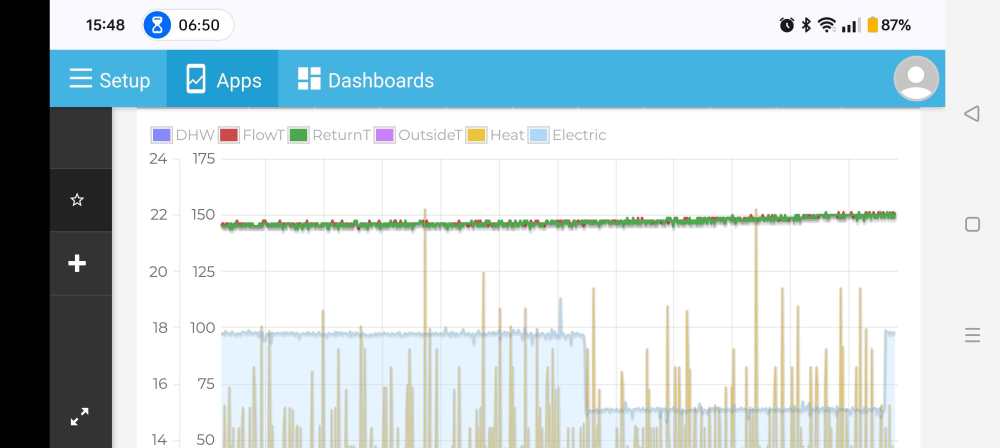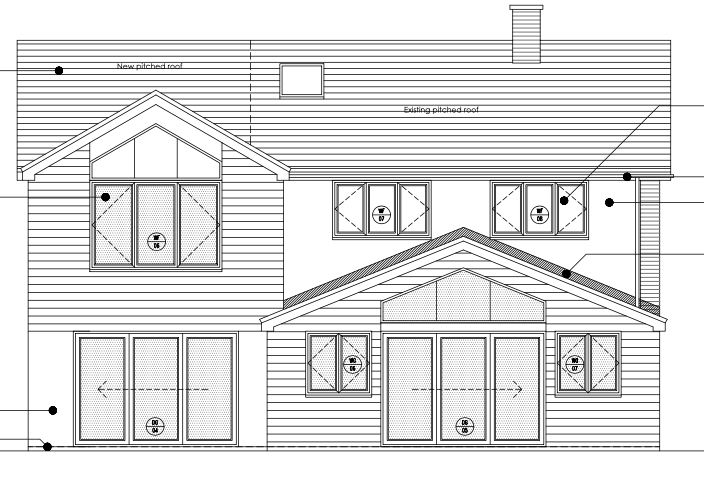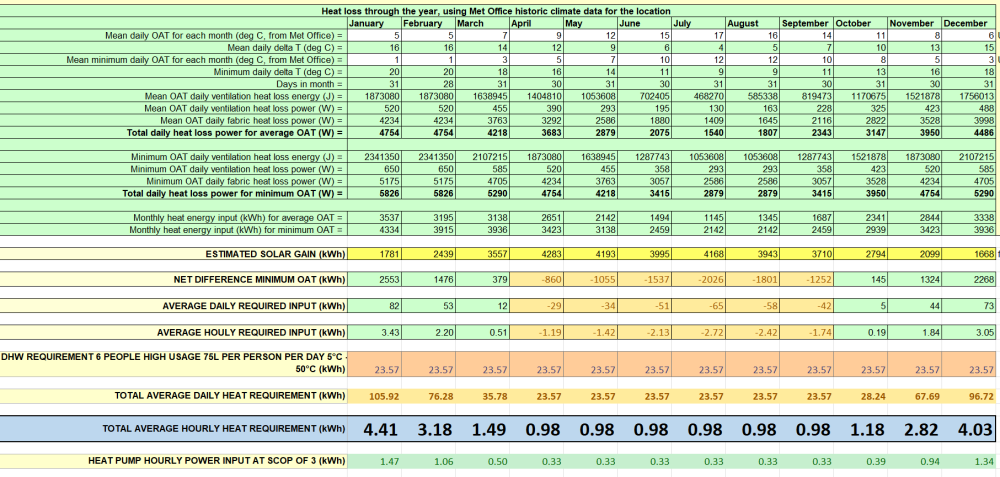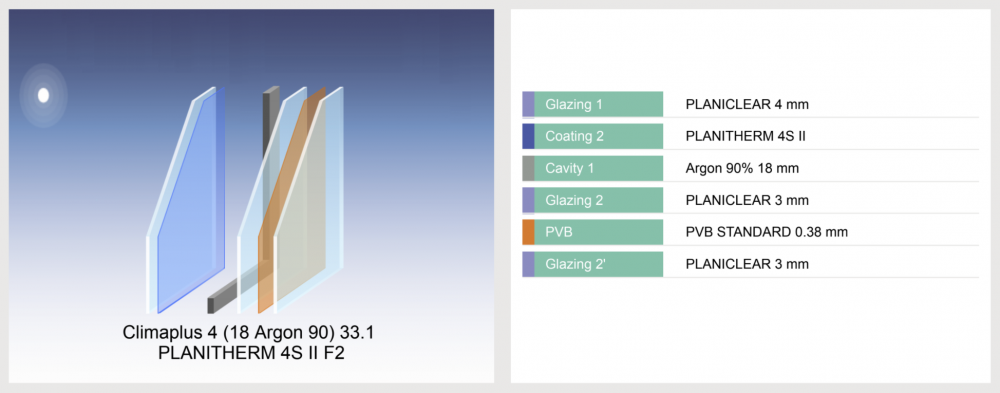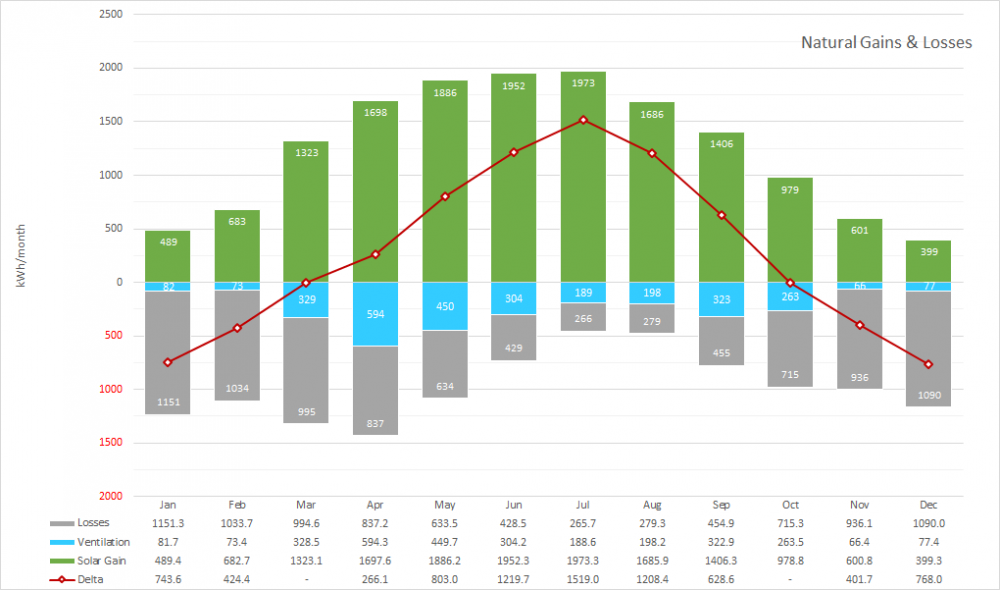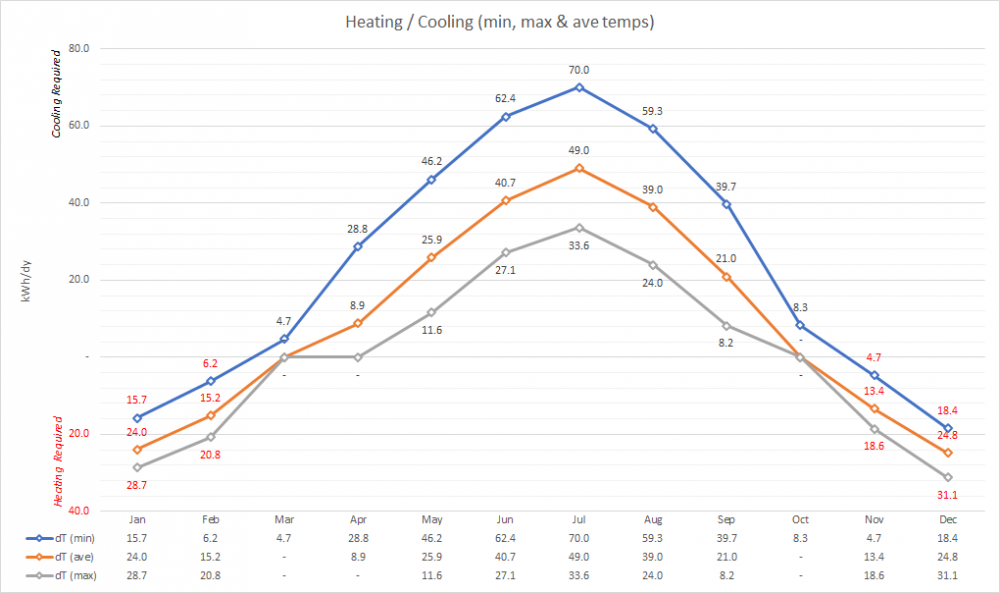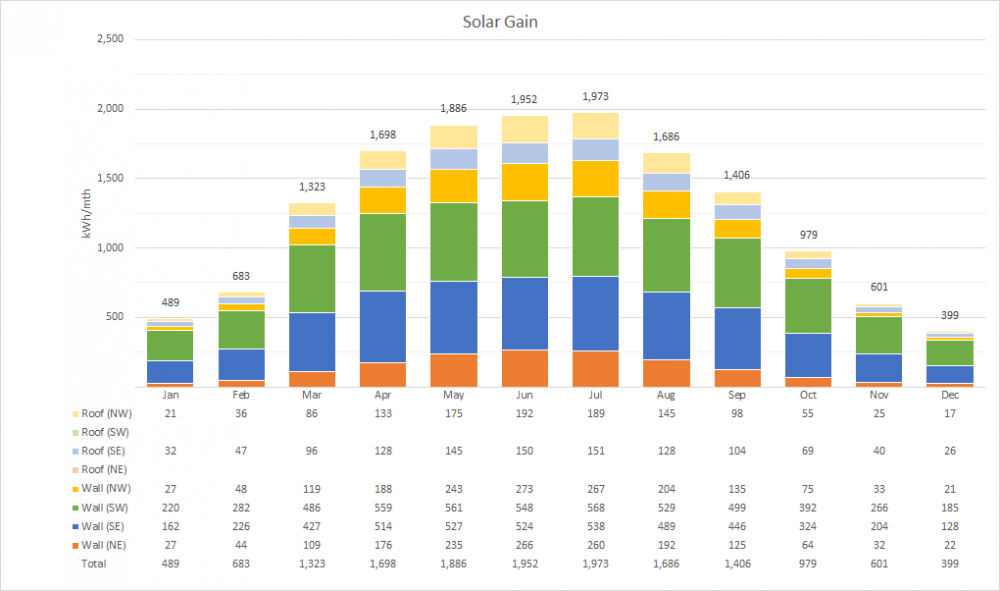Search the Community
Showing results for tags 'solar gain'.
-
Just been looking at ASHP monitor system, it shows the flow and return temperature among other things. Sun has been out since lunch time. You can see the floor absorbing house heat. For context the UFH pipes are at the bottom of 100mm of concrete, the main rooms to get solar gain are covered in glued down oak floor or carpet. The ASHP is in full WC mode with no mixers etc and circulation pump runs 24/7. Rise in temp is 0.5 degs on flow and return (green/red line) over 2 hrs.
- 6 replies
-
- ufh
- solar gain
-
(and 1 more)
Tagged with:
-
We're into the build phase of our renovation and currently engaging with glazing companies to supply and fit our windows and doors, alu / alu-clad. The rear of the house is SW facing and as such whilst we're looking forward to the 90% of the year when we can enjoy brighter rooms, we also need to plan for the height of summer. Given i have windows, gable glazing and bi-folds, maybe i need to adopt a couple of different approaches. Keen to learn from anyone that have gone before me
-
Evening, I have been looking, sourcing and trying to design a heating system for our barn conversion. I initially contacted several reputable GSHP/ASHP suppliers and they have come back with system designs with pumps in the region of 25kW to 30kW. Granted our property is quite large but I have been suspicious over their assumptions and calculations as none of them asked me any detailed questions about our build materials etc. Before just slinging something in I have consequently made the effort to use @Jeremy Harris Heat Loss Calculator, whilst at it I also used @Lilly_Pines Solar Gain Calculator. At the worst in January I have calculated a hourly requirement of 4.41 kWh if we exclude any solar gain it is 5.82 kWh. Now I can't understand why I would need a 30kWh capable pump? Either my calculations are too good to be true and the building will never perform so well in real life/a input mistake has been made... or the suppliers are massively overcompensating. Or am I missing something else? The next issue is (whether the above is right or wrong) is installing a system that can run on ASHP and another heat source. We are off-grid - so no choice but to use another source of heat. Probably oil for ease of use. However I am seriously considering using a boimass boiler or woodburner with back boiler, this would have to be connected up to a thermal store which from most forum posts is unpopular compared to UVC. (Why is that?) I have provided monthly solar generation from a 33kW Solar PV array as per https://re.jrc.ec.europa.eu/pvg_tools/en/tools.html I assume it is accurate enough - it is suggesting a PV generation in winter which is 19% of summer output which I have seen bounded around. If my calculations are correct I have expanded Jeremy's spread sheet to estimate oil usage and it is relatively negligible so burning wood seems unnecessary unless my calculations are all wrong... I have attached my spreadsheet for those interested/willing to have a look - I have noticed @SteamyTea is pretty good at crunching the numbers. Appreciate anyone's thoughts and opinions on the matter. Edit: this is a continuation of thoughts from a post a few months ago - appreciate the responses from everyone there but realised I lacked useful detail and my own calculations. Heat loss calculator - My Barn.xlsx
-
Just a quick sanity check. I've been told by a glazing company that fitting solar control glazing instead of clear will triple the cost of the glass (window frame cost excluded). Does this sound correct? This is for 2 large south facing full height windows in a loft that I don't want to turn into an oven. The specced glass is this:
-
We really like Internorm triple glazed windows....and pricing at the moment is not too bad. However, we had originally planned to have solar glass to reduce solar gain in the summer. Someone mentioned to me that solar glass on triple glazing can appear very dark. Does anyone have experience of/views on this pls?
-
Just for interest, a brief extract i came across from the Design Code at Gravenhill: https://www.self-build.co.uk/graven-hill-plot-passport-explained/ That line highlighted in red seems to me to be encouraging solar gain, rather than limiting it - as is more the need in well insulated houses. AIUI the solar gain factor (ie amount of energy from sunlight that gets through to the inside) should be below 0.5 in a highly insulated house. eg from Wikipedia https://en.wikipedia.org/wiki/Solar_gain However, this is not my specialism and the difference may be marginal. Ferdinand
-
I am a new member at the planning stage of a new build house for our retirement and looking to make it as comfortable, efficient and maintenance free as possible. I am trying to get my head round the many and various heating options – things have changed beyond recognition since we built our current house 35 years ago. The plan is that we will have one large room incorporating living/kitchen/dining. This will be on the first floor with ceiling at roof height and extensive glass to S & W to maximise the views. I know this isn't ideal, but we love the outdoors and the views are spectacular. Bedrooms all ground floor. My current thinking is to have wet UFH in concrete screed floors on both levels; either GSHP or ASHP (current preference). Can the ASHP be located in an outbuilding to avoid noise issues? My main concern is solar gain:- Can I utilise this free energy to heat the lower floors/DHW in winter (MVHR)?? How do I keep it cool as we experience the ever warm summers we are promised? (MVHR/AC/??) Thanks in advance
-
Has anyone installed external blinds. I have huge solar gain issues and need shading pdq. I was considering awnings but have seen external roller blinds on the internet and they look very good. Be interested in any feedback and recommended suppliers
- 41 replies
-
- solar gain
- shading
-
(and 1 more)
Tagged with:
-
This post covers more than just MVHR, but I wasn't quite sure where this post would be best placed. Admins feel free to relocate if need be! As you can probably guess by this post going up late on a Saturday, I've been doing a lot of modelling of our heating and energy systems for our house. It has taken a while to get the model to accurately reflect reality, but I think we've finally nailed it. Whilst not surprising, what it has clearly established is that: PV is a no brainier, provided you have the capital up front! Though that's another topic all together (posted here). The MVHR bypass will be insufficient to counter the solar gain during the peak summer months. It's often said that the biggest problem with passive houses (or near passive as our's is) isn't the heating, but the cooling. They're right! Thankfully we have opening windows and plans to use a canvas above our pergola to shade some of the southern windows. So more our of general curiosity, what else have people done to keep the tempretures stable and comfortable during the summer months?
-
With temperatures hitting 25C today this has been the first real test of our house in terms of overheating and how to manage excess heat. When I designed our house, I crunched the numbers, taking into account average and peak daily solar gain. Due to the large amount of SW facing glass that we have, I knew we were going to have some overheating, based on maintaining an internal air temperature of 21C. My number crunching indicated that summer overheating resulting from solar gain could be managed by means of the MVHR summer bypass, and opening a window and ventilating with cooler ambient air, and where appropriate, using blinds or drawing curtains. Up until now, ambient air temperature has always been several degrees lower than internal air temperature making it very easy to control how much of that solar gain we wished to retain. In practice we haven't had to do much in the way of control, as internal temps have not exceeded 23C in the main living areas, the bedrooms remaining 1C cooler as they are on the north side of our site. Today's challenge was how would the house perform without any cool ambient air or active cooling (albeit I do have the capability to cool our slab). I'll be honest and say I was quite concerned, but I'm glad to report that internal temperatures remained lower than external, peaking at 24C in the living areas, 1C cooler in the bedrooms. As ambient air temperature fell to 21C late this afternoon, the summer bypass kicked in and began to ventilate cooler ambient air inside (interestingly, when ambient air was higher than internal, the bypass didn't activate) and I opened two windows, one on the ground floor and the velux on the 1st floor mezzanine to create a natural draw through the house to purge some of the warm air out. This worked brilliantly and rapidly reduced the internal air temperature down to 22C, and shows how effective this method of control is. How did everyone else fare today?
- 38 replies
-
- overheating
- solar gain
-
(and 2 more)
Tagged with:


